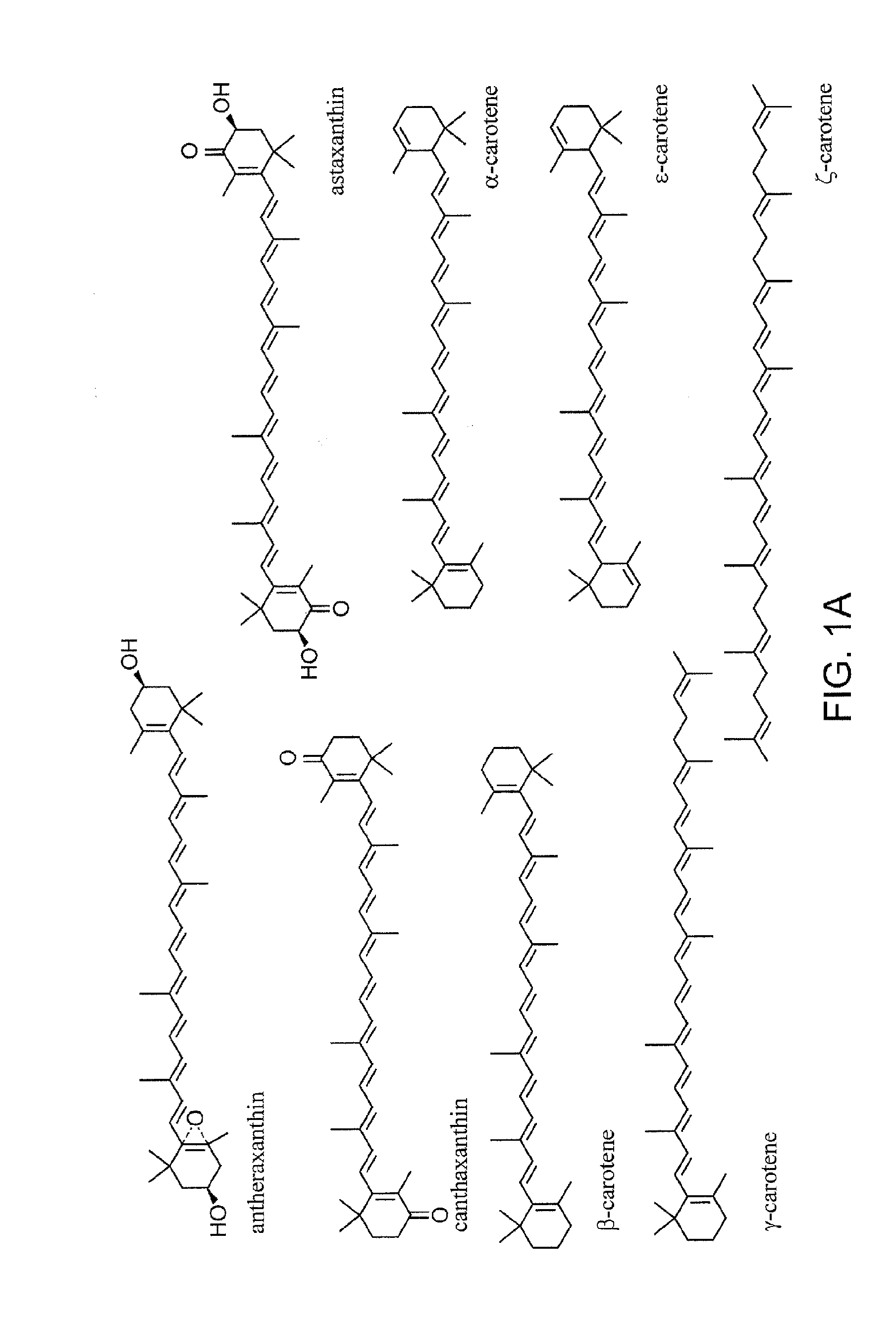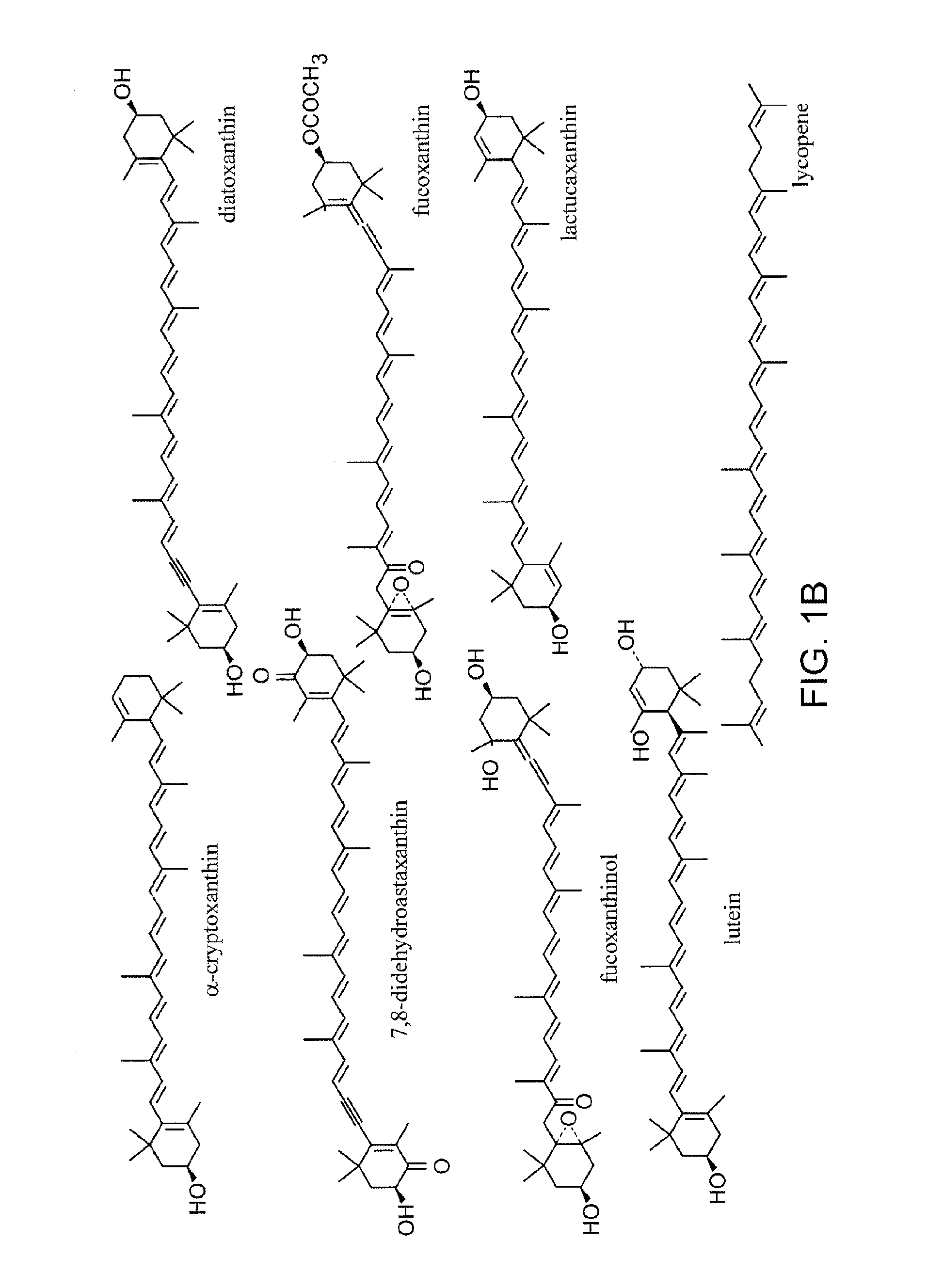Production of carotenoids in oleaginous yeast and fungi
a technology of oleaginous yeast and carotenoids, which is applied in the field of production of carotenoids in oleaginous yeast and fungi, can solve the problems that animals cannot produce carotenoids, commercial scale isolation is not practicable, etc., and achieves the effects of increasing the expression or activity of an ipp isomerase polypeptide, increasing the expression or activity of an fpp synthase polypeptide, and increasing the expression or activity of an
- Summary
- Abstract
- Description
- Claims
- Application Information
AI Technical Summary
Benefits of technology
Problems solved by technology
Method used
Image
Examples
example 1
Production of Plasmids for Carotenoid Strain Construction
[0275]Plasmids were generated for construction of carotenoid producing strains. The following subparts describe production of plasmids encoding carotenogenic polypeptides. Plasmids used in these studies and details of their construction are described in Table 27. Additional plasmid construction details and descriptions of their use are found in the text of the relevant subsection. All PCR amplifications used NRRL Y-1095 genomic DNA as template unless otherwise specified. The URA5 gene described below is allelic with the ura2-21 auxotrophy above. The GPD1 and TEF1 promoters are from Y. lipolytica as is the XPR2 terminator.
[0276]GGS1 is the gene encoding the Y. lipolytica gene encoding geranylgeranylpyrophosphate synthase. The nucleic acid coding sequence, and encoded Ggs1 protein of pMB4591 and pMB4683 are as follows:
(SED ID NO: 1)atggattataacagcgcggatttcaaggagatatggggcaaggccgccgacaccgcgctgctgggaccgtacaactacctcgccaacaaccggggcca...
example 2
Engineering Yarrowia lipolytica for Increased Carotenoid Production
2A. Production of Y. Lipolytica Expressing Geranylgeranylpyrophosphate Synthase and Phytoene Dehydrogenase:
[0313]MF350 (MATB ura2-21 leu2-35 ade1) was transformed with pMB4591 (tef1p-GGS1) that had been cleaved upstream of URA5 with SspI; a Ura− transformant carrying the plasmid at the ura2 locus was identified and named MF364. It was subsequently transformed with pMB4638 (tef1p-carB) that had been cleaved at ADE1 with SspI and a prototrophic transformant was chosen that harbored the plasmid at the ade1 locus. This strain was named MF502.
2B. Production of Y. Lipolytica Expressing Geranylgeranylpyrophosphate Synthase, Phytoene Dehydrogenase and Phytoene Synthase / Lycopene Cyclase
[0314]MF502 was transformed with pMB4705 (tef1p-carRP[i−]) that had been treated with SspI. Ninety percent of the prototrophic transformants were very orange on YPD agar plates, and one, MF719, produced greater than 10 mg carotene per g dry cel...
example 3
Extraction of Carotenoids
[0332]3a: Total Extraction of Carotenoids from Yarrowia lipolytica Cells
[0333]Yarrowia lipolytica cultures to be tested for carotenoid production were grown in 20 ml YPD medium (1% yeast extract, 2% peptone, 2% glucose) in 125 flasks at 30° C. Following incubation for 72-96 hr, the cultures were harvested by centrifugation and the solvent extractions were performed to determine carotenoid form and quantity. Dry cell weights were determined by transferring 1.8 ml of each culture to an Eppendorf tube, which was then centrifuged to pellet the cells, and then the pellet washed twice with 1 ml water. After the second wash, the cells were resuspended in water and transferred to a pre-weighed snap-cap tube with a hole poked in the top, frozen, and then lyophilized overnight. After drying to constant weight, the tube was weighed in order to calculate dry cell weight (mg dry cell weight / ml).
[0334]The carotenoid content of the culture was calculated by solvent extract...
PUM
| Property | Measurement | Unit |
|---|---|---|
| weight | aaaaa | aaaaa |
| dry cell weight | aaaaa | aaaaa |
Abstract
Description
Claims
Application Information
 Login to View More
Login to View More - R&D Engineer
- R&D Manager
- IP Professional
- Industry Leading Data Capabilities
- Powerful AI technology
- Patent DNA Extraction
Browse by: Latest US Patents, China's latest patents, Technical Efficacy Thesaurus, Application Domain, Technology Topic, Popular Technical Reports.
© 2024 PatSnap. All rights reserved.Legal|Privacy policy|Modern Slavery Act Transparency Statement|Sitemap|About US| Contact US: help@patsnap.com










